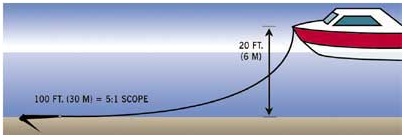The following anchor tips are provided as a guide only to assist you in determining your anchor size for your requirements.
A “Lunch Hook” (Danforth) anchor should be able to hold your boat in a 15 knot breeze. A main, or “Working Anchor” (Plow type) should hold up to 30 knots of wind. A “Storm Anchor” is for winds up to 42 knots.
Remember…as wind speed doubles, the holding requirement quadruples!
1. Determine Your Holding Requirements.


Use the “Horizontal Loads Table” above to determine your holding power requirements for different wind speeds.
NOTE: These tables assume boats of average beam and windage. If your boat has above average beam or windage, refer to loads for the next larger size boat.
2. Use Adequate Scope.
Scope is the length of anchor line relative to the distance from your boat’s deck to the sea bottom. We recommend at least 5:1 scope.

At 10:1 the holding power will double, and at less than 3:1 you will give up a significant amount of holding power and may experience problems setting the anchor.

In crowded anchorages “Power Set” your anchor at 5:1 scope, then shorten scope as required. Remember that your depth sounder may be giving you the water depth under your keel, rather than from the true waterline, in which case you need to add your draft plus the height of your deck when calculating scope.
3. “Power Set” Your Anchor.
Know that your anchor is properly set! Back down very, very slowly. Then as the anchor begins to set, very slowly increase the load with your engine. Backing down at any speed at all may not give your anchor a chance to dig in and bury itself.
You can simulate the force of the wind by using your engine’s thrust to set your anchor to a predetermined load. Match your boat’s total maximum horsepower and hull type in the table below to determine how hard your boat can “Power Set” your anchor.

4. Anchor Resetting.
In areas of changing tide or wind, set two anchors off the bow in opposite directions. Any anchor can occasionally fail to reset once it has been pulled out of the bottom.

Don’t be fooled by some manufacturer’s claims about any anchor’s ability to reset 100% of the time! Set two anchors if you expect a change in wind or current.
5. Anchor Retrieval.
Slowly move the boat to a position directly over the anchor, pulling in the line as you go. If you are anchored on a sand or mud bottom you can snub the line on a cleat and power backwards slowly to pull the anchor out of the bottom.
6. Support Hardware.
Remember that your anchor system includes the shackle, rope, chain, and deck cleats. Every item must be able to deliver the strength you need.
7. Anchor Rode.
Use a short length of chain and three strand nylon line. The nylon is very elastic and greatly reduces shock loads on your boat and it’s anchoring system. The chain protects the line against chafe from the sea bed and also help provide horizontal pull on the anchor when it is initially beginning to set. If you regularly anchor in 25 ft (8 m) of water or less, use 6 ft (2 m) of chain. For greater depths, use 6 ft (2 m) for every 25 ft (8 m) of water depth. (i.e. use 24 ft (7 m) of chain if you regularly anchor in 100 ft (30 m) of water).

All chain anchor rodes lack the shock absorbing ability of nylon rope when the wind pipes up!
8. Soft Mud Bottoms.
All soft mud bottoms offer greatly reduced holding power, so be sure your anchor can provide the holding power you need. Some bottoms offer as little as just 15% of the holding available in firmer bottoms!

Some soft mud bottoms have a sticky consistency which makes them difficult to set an anchor in. If soft mud setting problems occur, try setting the anchor initially at very short scope, e.g. 2:1. Then, increase the scope to at least 5:1 and “Power Set” the anchor. Special “Mud Palms” are available from some anchor manufacturers (both Fortress and Guardian anchors). We recommend that you install the “Mud Palms” on your anchor, as they help the anchor set faster in any type of bottom.